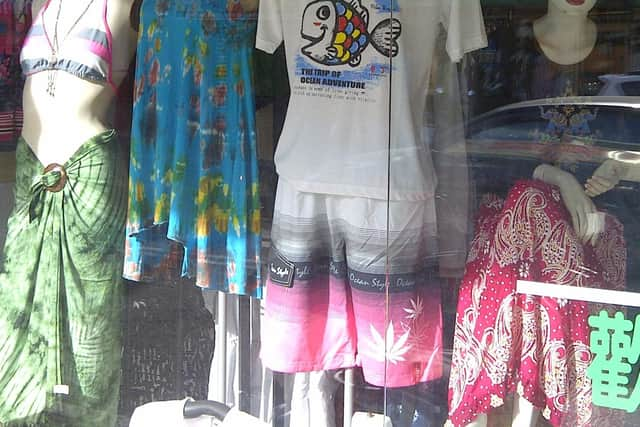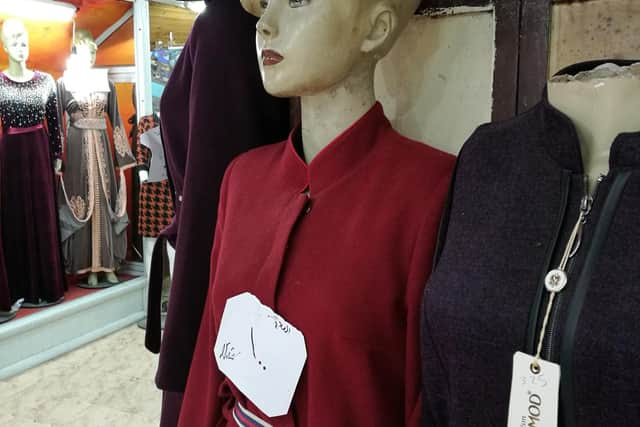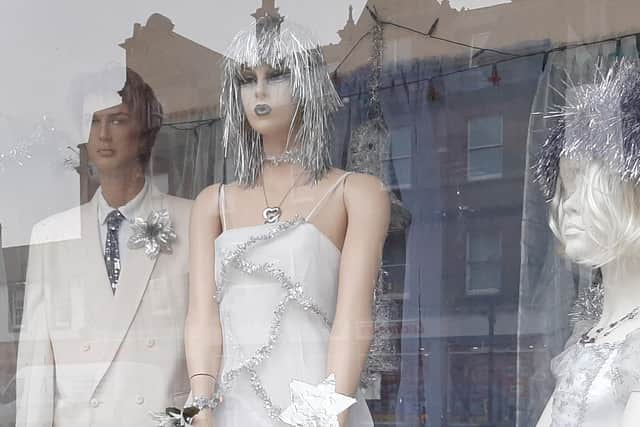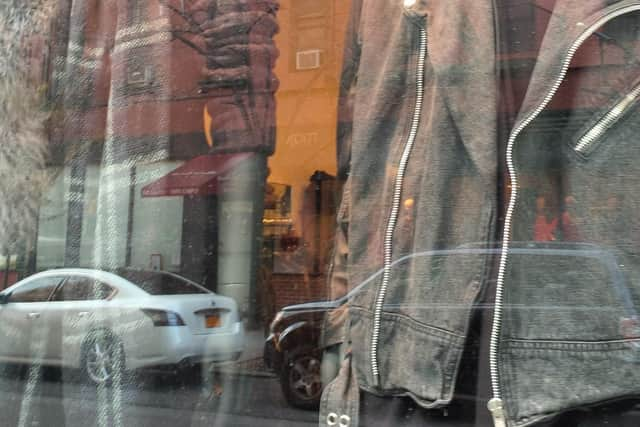With Manikins, his light-hearted look at shop window mannequins, bookseller, museum director and art historian Mark Jones shines a light in lockdown
and live on Freeview channel 276
There’s nothing that says lockdown more than our high streets right now with empty store windows displaying mannequins gazing out unseeing at absent shoppers. Closed on Boxing Day, many never to re-open, the shops are a window on a society stuck in time, their dummies trailing Christmas tinsel signalling a melancholy that sums up the mood while we wait, and hope, for business as usual.
For Mark Jones, the mannequins that fill shop windows have a fascination that dates back long before the pandemic, in fact he’s spent the last few decades photographing them, from Annan to Manhattan to Malawi, and the result is his captivating and curious book, Manikins.
A lighthearted look and playful paean to the plastic people behind the panes, it’s a tribute to mannequins everywhere and a work of art in itself, which is what you might expect from a man who has made a career out of display.
An acclaimed art historian and museum director, as director of the National Museums of Scotland, Jones was knighted for services to the arts in 2010, oversaw the creation of the prize-winning Museum in Edinburgh, and went on to be director of the Victoria and Albert Museum in London from 2001 to 2010. A lover of words as well as images, in 2012 he set up the Golden Hare Bookshop in Edinburgh’s Stockbridge, winner of the best independent bookshop in the British Book Awards 2019.
Now Jones has now combined these twin talents in a title that pairs photos with poems that seem to say something about the nature of our existence by framing the remarkable in the mundane and the curious in the quotidian. After all, who hasn’t stood and gazed at a shop window with its motionless mannequins?
“It’s about the mad things people do in shop window fronts,” he says. “It’s quite extraordinary sometimes. There’s one from Annan which is like a fairy wedding scene. It’s all sparkly and she’s got a wand; it’s just mad.”
“You see such extraordinary things in the street, but you don’t see them because you’re used to them. However, if you photograph them and put them in a different context, then the oddness of them comes out. And I like that.”


Manikins came out of lockdown. With Jones’s bookshop open online, he found himself with time on his hands and was inspired to turn his stash of mannequin photographs into a book.
“I think it must have been a case of lockdown fever. I’d got various projects I was working on and then I suddenly thought I’d really like to do something with those photographs of mannequins.
“I’ve been interested in them for quite a long time and I thought now is the time to do it. So I made a selection from the photographs I had taken over the years and put them together with some poems.”
Originating from cities and towns on Jones’ journeys all over the world in the UK, US, Europe, Africa, Taiwan and Turkey, the photographs show dummies staring out from shop windows from Annan, Bristol, Carlisle, London, New York, Jerusalem, Venice, Vienna and Gocek to Langon and Lilongwe.


Aged 70, Jones, lives in Edinburgh’s India Street with his wife Camilla Toulmin, economist and former Director of the International Institute for Environment and Development and the pair have travelled extensively in the past.
Does Toulmin share his fascination with mannequins?
“No, I don’t think so; she looks on it with amused tolerance probably,” he says and laughs.
With lockdown curtailing their travels, his thoughts turned to places they had visited and his habit of cataloguing a destination by the displays he found there.


“When you’re in a new place - for example we went to visit our son in Taipei and we hadn’t been to Taiwan before - one of the ways you encounter it is through its markets and shops,” he says, “so I got into the habit of looking out for these particular kinds of scenes, the presence of the mannequins and the way things are displayed and I just tend to take them when we’re traveling. But the lack of any travel made me decide to turn it into a little book.”
Jones’ interest isn’t just in the mannequins themselves, but also about the way they’re dressed, their surroundings, the shop window fronts and what the shopkeepers reveal about themselves with their displays.
Many stores adhere to the logic of wanting the clothes to look as desirable as possible, but there are others that appear to take a different tack.
“I’m completely confused by some of them,” he says. “There’s one from Naples where her whole thing is she looks really fed up. I wonder why the shopkeeper decided that was a look they wanted for their clothes. And the ones on the back cover always look really sulky to me.”
As well as Annan’s fairy bride, there’s a snarling female rapper in Naples, an athletic android in shorts about to do a runner in Vienna, heads trapped in cages in Carlisle and a very spooky, eyes-follow-you ventriloquist dummy lookalike sporting a cheery Christmas jumper in New York, bewildered children in Malawi, a cheeky trio baring bum cheeks in Langon, rows of harem-panted legs in Turkey, and sulky in sweaters in Taiwan.
With an eye for the absurd, Jones enjoys the comic element of the interplay between man and mannequin.


“It’s funny, sometimes you get what appears to be an interaction between the different mannequins in the shop window or between the mannequin and the passerby. In one of the pictures in New York the mannequin seems about to launch himself aggressively on a passerby.” He laughs.
“Of course I’m interested in design, because it’s very revealing both about the maker and the consumer of the design. It tells you quite a lot about how society is working and what its unspoken assumptions are. Although I’m not claiming to decode the mannequin - that’s way beyond me - I hope that this collection might make people just take a look and see them for themselves.”
What also struck Jones as he gazed, was that the reaction to the displays might not be quite so straightforward as ‘I wonder if they have that mankini in peach’?
“They’re meant to be selling so they ought to make you feel very positive about the clothes and generally ‘up’,” he says, “but actually what I noticed is how often there was a sense of melancholy associated with them. Maybe it’s my melancholy I’m reading into them. But why not? You can read things into them. Sometimes there’s a sense of sadness, sometimes, weirdly there’s a sense of rage coming out of them, sometimes there’s a sense that they‘ve been abandoned. You can project onto them.”
Another element to the Manikin photographs is the reflections of the street and surroundings bounced off the shop window; leafless trees against darkening skies in Carlisle, ornate black metal balconies in France and New York blocks accessorized with zig zag metal fire escapes.
“Whether you like it or not, when you’re taking photographs of and through shop windows, there’s this wonderful mixture of the reflection of the street scene and the contents of the shop. I know I’m not the first to notice it but that doesn’t stop me enjoying it,” says Jones.
Through the prism of lockdown, with the high streets empty and the shops deserted, it’s as if the mannequins have taken on a more active role, populating places once thronged by people. After all the word mannequin is a French derivation of the Flemish word manneken, or ‘little man’, meaning figurine?
“In a way you imagine them as being trapped because they’re always behind glass,” says Jones. “And some look very distinctly trapped, for example in one I took in Carlisle in the department store before it closed. They’re there in the window with steel boxes around their heads.
“So there is this sense of people, of course they’re not people they're mannequins, but nevertheless images of people, behind glass, isolated and trapped and there was something about the experience of lockdown that sometimes made me feel the world had become a strange place and that you were rather trapped.”
This winter our high streets with their shut shops and redundant restaurants have taken on the same abandoned air as seaside proms in winter, or ski resorts in summer.
“It’s that American road movie thing, the romance of the abandoned gas stations and derelict amusement parks, particularly when it affects things which are supposed to be fun, that is rather moving and melancholy.”
“I remember once driving out from Las Vegas at sunrise and there’s a place with abandoned rides and there was something very beautiful and sad about them against the desert.”
As Jones points out, often it’s not what the dummies are trying to say or sell, but the response they elicit in the viewer, a consideration that led him to pairing the pictures with some of his favourite verses.
“In putting them with poems I was not trying to direct people to think about them in any particular way but simply to suggest that there are dimensions to one’s reactions which are sometimes unexpected.”
Other things about mannequins have caught Jones’ attention, such as their ubiquity in global terms, something that is reflected in his pictures as he trotted around the globe.
“If you were to look at this tiny book and try to guess where the mannequins came from without looking at the captions, it’s surprisingly difficult. Often there's a give away because there’s a reflection of a New York street, for instance, but actually, mannequins in Taiwan are not as different from mannequins in Syria or Malawi as you might expect. There are great similarities, but then you come across great differences, so that interested me. There are odd things.”
As fashions and cultural values change, Jones can trace an evolution away from the detail of realistic dummies, to a globalised universality, reflected in abstract forms.
“If you look at the old mannequins they very often represent what could be an individual, but the current ones are often faceless and even headless, and I think that probably comes out of an anxiety of excluding representing anything particular and therefore excluding anyone who didn’t share say the colour of skin, eyes, height, body type. I think people are more and more wary of suggesting there’s an ideal.”
“That all sounds a bit serious, and it is serious, but this is not meant to be an academic work,” he says, “but rather a playful thing which everyone can enjoy in a different way.”
Another theme Jones found replicated worldwide in store windows is the white wedding dress, often in places where you wouldn’t expect to see a traditional puffy meringue frock, but the mannequins bear witness to its presence in the marriage rituals of various cultures.
“If you travel around the world the white wedding dress crops up even in surprising circumstances. There might be a moment where even in an Indian or Taiwanese wedding in which suddenly the bride dons a white wedding dress. It’s a cultural phenomenon, which goes around the world.”
Comparisons have been made between Jones’s images and those of French photographer Eugène Atget who photographed mannequins in Parisian shop windows in the early 20th century.
“There are similarities,” he says, “but I’ve just been going round taking photographs of what I see in shop windows so they tend to be mostly late 20th century,” he says, “and some 21st century.”
Echoes of the 20th century German artist, photographer and sculptor Hans Bellmer, who was also fascinated by mannequins, are more off the mark for Jones. Bellmer's art served as a form of personal therapy by the objectification of abusive relationships and exploration of fantasies, using dummies.
“His work concentrated a lot on dislocated mannequins and there’s a sense of a kind of subliminal gratification arising from the dismemberment of the mannequins which is very disturbing, and I’m not really into that,” he says.
Another difference to the work of others is that Jones paired his photographs with poems, and Manikins features verses by Zhuang Zhou, Rumi, Omar Khayyam, Emily Dickinson, and John Clare among others.
“I went to poets and translations of poets, particularly Chinese poetry which I personally like, and selected them for their value as brief extracts from the poetic work of people whose work I think is interesting.
“The reason I matched them with the images was I wanted people to think about how you read meanings into things. I’m not saying that a Chinese poet writing in 2nd Century BC is in some direct way linked to a 20th century mannequin, obviously they’re not, but I wanted to raise the question of the universality of human thought and experience and how in a funny sort of way they do seem to bounce off each other.
“There is some communication between the image and the text but it’s meant to be elliptical, suggestive. That was the bit that took me the longest. But I didn’t take it too seriously.
The most directly linked to a shop front image is a Chinese poem by Su Tung-Po, writing in 11th-century China, which reads:
“Families, when a child is born
Want it to be intelligent.
I, through intelligence,
Having wrecked my whole life,
Only hope the baby will prove
Ignorant and stupid.
Then he will crown a tranquil life
By becoming a Cabinet Minister.”
“I paired this with three male mannequins with bare bottoms,” says Jones. “You might say what is the relationship between those two? I just think one is the visual equivalent of the other.”
Manikins by Mark Jones, Golden Hare Books, £9.50